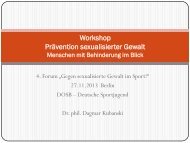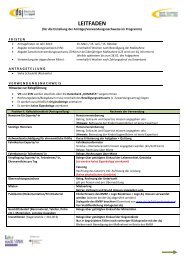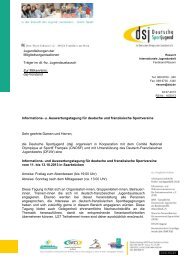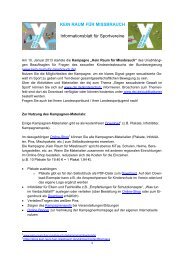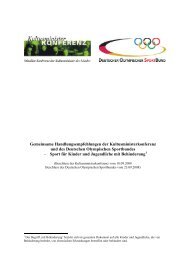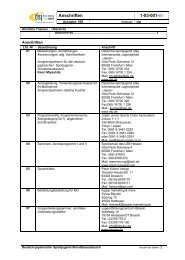Sexual harassment
Sexual harassment
Sexual harassment
You also want an ePaper? Increase the reach of your titles
YUMPU automatically turns print PDFs into web optimized ePapers that Google loves.
What do we know about<br />
sexual <strong>harassment</strong> and<br />
abuse in sport in Europe<br />
Professor Kari Fasting (kari.fasting@nih.no)<br />
Norwegian School of Sport Sciences<br />
Key note speech presented at The European conference<br />
“Safer, better, stronger! Prevention of <strong>Sexual</strong> Harassment<br />
and Abuse in Sport<br />
Berlin, 20-21 November, 2012
• What are we talking about –<br />
defintions<br />
• Why is it so difficult to<br />
research and study<br />
• What do we know about:<br />
• The prevalence<br />
• The consequences<br />
• The risk factors<br />
• The perpetrators<br />
Outline
Central in most definitions of sexual<br />
<strong>harassment</strong> and abuse is that the<br />
behavior experienced is:<br />
• Unwanted<br />
• Threatening<br />
• Troublesome<br />
• Insulting<br />
• Offensive<br />
• Coherced/Forced<br />
• Abuse of Power
Identifying Gender Gender, , <strong>Sexual</strong> Harassment and<br />
Abuse<br />
• Gender <strong>harassment</strong> refers to a broad range of verbal and nonverbal<br />
behaviours not aiming at sexual cooperation but conveying insulting,<br />
hostile, and degrading attitudes about one gender (male or female),<br />
• <strong>Sexual</strong> <strong>harassment</strong> refers to behaviour towards an individual or<br />
group that involves sexualised verbal, non-verbal or physical<br />
behaviour, whether intended or unintended, legal or illegal, that is<br />
based upon an abuse of power and trust and that is considered by<br />
the victim or a bystander to be unwanted or coerced.<br />
• Common for definitions of sexual abuse is that it is non-consensual<br />
sexual contact and that it is forced or coerced. <strong>Sexual</strong> abuse involves<br />
any sexual activity where consent is not or cannot be given.
Examples of gender- , sexual <strong>harassment</strong> and abuse<br />
• Verbal<br />
• Derogatory or demeaning jokes and comments of a sexual nature<br />
• Repeated unwanted sexual proposals or invitations concerning<br />
sexual behavior<br />
• Ridicule or sexist jokes about women in general<br />
• Non-verbal<br />
• Unwanted sexual suggestions, whistling, sexual staring and leering<br />
about one’s body, clothes or private life<br />
• Unwanted telephone calls, sms or letters with sexual content<br />
• Being shown pictures or things with unwanted sexual content<br />
• Physical<br />
• Unwanted touching of a sexual nature,<br />
• pinching<br />
• attempted kissing<br />
• unwanted body contact and body pressing<br />
• Forced into sexual acts<br />
• Attempted rape and rape
<strong>Sexual</strong> exploitation continuum (Adapted from<br />
Brackenridge 1997)<br />
The spectrum<br />
SEX DISCRIMINATION<br />
"the chilly climate”<br />
e.g. worse pay, facilities or<br />
coaching for one sex<br />
bystanding<br />
GENDER & SEXUAL HARASSMENT<br />
"unwanted attention”<br />
e.g. sexual ridicule, jokes,<br />
stalking, bullying, homophobic<br />
taunts<br />
<strong>Sexual</strong> <strong>harassment</strong><br />
Gender <strong>harassment</strong><br />
Trans <strong>harassment</strong><br />
Homophobia<br />
SEXUAL ABUSE<br />
I N S T I T U T I O N A L ............…………………...……………………P E R S O N A L<br />
"groomed or coerced”<br />
e.g. sexual violence, assault,<br />
rape, sexual favors, groping,<br />
incest<br />
Grooming<br />
Hazing<br />
<strong>Sexual</strong> abuse
Process of<br />
Grooming/persuasion<br />
The process of grooming can be said to be the tool the<br />
abuser may employ to gain a position from which to carry<br />
out the abuse. The process of grooming and/or coercing<br />
someone for sexual abuse means that one slowly gains the<br />
trust of a person before systematically breaking down<br />
interpersonal barriers. The young athletes can become<br />
trapped, because his or her compliance is assured by using<br />
threats such as being cut from the team and/or giving or<br />
withholding privileges (Bringer et al 2002).
Prevalence<br />
Prevalence: : <strong>Sexual</strong> <strong>harassment</strong> and abuse in<br />
sport<br />
• SH varies between 14 - 73 %<br />
• SA varies between 2-22 %<br />
(Tomlinson and Yorganci 1997, Klein,<br />
M. & Palzkill, B. 1998), Cense &<br />
Brackenridge 2001, Brackenridge<br />
1997, Feigin and Hageby 2001,<br />
Brackenridge & Fasting 2008,<br />
Toftegård Nielsen 1998, 2004,<br />
Fasting & Knorre 2005, Jolly &<br />
Décamps (2006)., Gündüz et al 2007,<br />
Vanden Auweele et al 2008, Chroni &<br />
Fasting 2009, Alexander et al 2011,<br />
Hartill 2011, Fasting et al 2000, 2003,<br />
2004, 2011, 2012,.<br />
• Belgium<br />
• Czech Republic<br />
• Denmark<br />
• France<br />
• Germany<br />
• Greece<br />
• Netherlands<br />
• Norway<br />
• Turkey<br />
• UK
Female athletes’experiences of<br />
sexual <strong>harassment</strong> in sport (Fasting et<br />
al 2000, Fasting & Knorre 2005)
Forms of sexual <strong>harassment</strong><br />
and abuse from a coach<br />
• “… when we didn’t perform well, then the<br />
punishment was that we should sit on his lap. I<br />
remember I thought it was disgusting. He touched<br />
us and was really very disgusting. I don’t<br />
understand today that we accepted it at all. We<br />
had a drill where we had to sprint, and the one<br />
who came last had to sit on his lap, so everyone<br />
was running like hell…” (Fasting et al 2002)
Forms of sexual <strong>harassment</strong><br />
and abuse from a coach<br />
• “It happens quite often that people try to hug<br />
people, but with this particular coach it is very<br />
clear that it was in a sexual context, so you have<br />
to be really insistent to keep him away from<br />
yourself. I experienced it as unpleasant…..It<br />
mainly happens during the training where he<br />
uses opportunities like when someone is coming<br />
to practice and he comes to hug and says I’m<br />
really glad to see you. But during the hug he can<br />
move his hands on the body, which is<br />
unpleasant.” (Fasting and Knorre 2005)
<strong>Sexual</strong> <strong>harassment</strong> and abuse<br />
seems to occur in all sports
The experiences of children participating in organised<br />
sport in the UK. London: NSPCC. (Alexander, Stafford<br />
and Lewis 2011) N= 6000<br />
• Experiences of sexual<br />
<strong>harassment</strong>: 29 %<br />
• Experiences of sexual<br />
behaviour and sexual<br />
harm (abuse): 3 %
Czech female athletes’ experiences of<br />
sexual <strong>harassment</strong> in sport for different<br />
sport groups (Fasting & Knorre 2005)<br />
60<br />
50<br />
40<br />
30<br />
20<br />
10<br />
0<br />
55 % 44 %<br />
30 %<br />
Elite Non-elite Exercisers
The experiences of children participating in<br />
organised sport in the UK. London: NSPCC.<br />
(Alexander, Stafford and Lewis 2011) N= 6000<br />
Forms of SHA Women Men<br />
<strong>Sexual</strong> <strong>harassment</strong> 34% 17%<br />
<strong>Sexual</strong> abuse 2 % 5 %<br />
-----------------------------<br />
-------<br />
Non-physical SH<br />
-----------------------------<br />
------<br />
73 %<br />
-----------------------------<br />
-------<br />
58 %<br />
Physical SH 33 % 38 %
<strong>Sexual</strong> <strong>harassment</strong> from men inside sport<br />
experienced by female sport students in<br />
Czech Republic, Greece, and Norway
European female sport students<br />
experiences of sexual <strong>harassment</strong> in<br />
sport and education (Fasting et al. 2012)<br />
SH from male coach<br />
17,8 %<br />
SH from males in sport<br />
33,5 %<br />
SH from male athlete<br />
22,6 %<br />
SH from males in sport<br />
and/or in education<br />
50,5 %<br />
SH from male teacher<br />
17,0 %<br />
SH from males in<br />
education<br />
38,0 %<br />
SH from male student<br />
• 28,7 %<br />
28,7 %
Key messaging:<br />
the power of the coach<br />
• There seems to be a higher prevalence of sexual<br />
<strong>harassment</strong> experiences from coaches among athletes<br />
who have experienced authoritarian behaviors compared<br />
to athletes that have not had such coaches<br />
• Authoritarian coaching behavior is characterized by<br />
negative feedback, screaming, rough language, directive<br />
communication, coach-led decision making, taskcentered<br />
role orientation and goal oriented performance<br />
• One of the characterstics of authoritarian coaching is<br />
therefore the risk of overlooking and intruding on the<br />
needs and wills of the athletes since the atlethe is left out<br />
of important processes in the relationship. (Sand et al<br />
2011)
What is the impact of experiences of sexual<br />
<strong>harassment</strong> in a sport setting? setting<br />
• Drop out/leave sport<br />
? (Fasting Fasting et al 2002)<br />
• Damaged coach-athlete relationship and changes in behavior<br />
towards the coach<br />
• Difficult to concentrate when the harasser was around<br />
• Feelings of anger, irritability, confusion, and anxiety<br />
• Negative effects on self-esteem and body image<br />
• Changes in behavior towards other men and other coaches<br />
• Decline in practice and performance<br />
• Decreased satisfaction with one’s performance<br />
• Decreased self-confidence in relation to one’s sport’s skill<br />
• Decreased motivation for participating<br />
• A negative effect on the relationship to teammates
Risk Factors - Athletes<br />
• Poor relationship with their parents so the perpetrator has a chance to get<br />
close to the victims:<br />
• especially on tours,<br />
• during massage,<br />
• at the coach’s home and<br />
• during drives to and from practice<br />
• affords the coach complete control of her life<br />
• is totally dedicated to the coach or authority figure who assumes the status of<br />
a father figure<br />
• When athletes are unaware of their rights and those that work with them do<br />
not know how to identify indicators of <strong>harassment</strong> and abuse or what to do<br />
when they are concerned<br />
• They are at pre-peak performance level and dependent on coaches and their<br />
entourages for success, team selection, are more likely to be away from home
Selected risks factors factors- Sports<br />
(Brackenridge 2001, Fasting 2011 2011)<br />
The organizational structure<br />
• involves an hierarchical status<br />
system<br />
• gives rewards based on<br />
performance<br />
• has no formal procedures for<br />
screening, hiring and monitoring staff<br />
• technical/task demands legitimate<br />
touch<br />
• there is no guidance about expected<br />
standards of behavior such as codes<br />
of conduct and ethics<br />
• there are no mechanisms for<br />
athletes and others to report<br />
concerns or to have them responded<br />
to, i.e. there is a lack of protection,<br />
such as protection policies and<br />
procedure, education and training<br />
The organizational culture<br />
• Cultures of tolerance to<br />
homophobia and gender<br />
<strong>harassment</strong> exist unchallenged<br />
• has an autocratic authority system<br />
• involves close personal contact<br />
with athletes<br />
• sets up clear power imbalance<br />
between athlete and coach<br />
• gives scope for separation of<br />
athlete from peers in time and<br />
space<br />
• involves mixed sexes and ages<br />
sharing room on away trips



